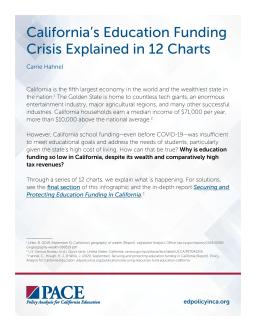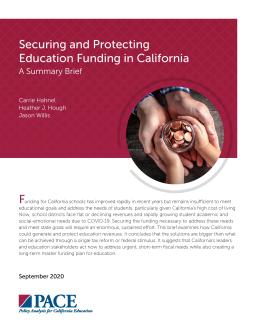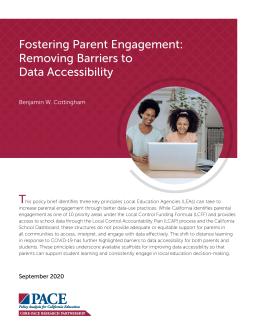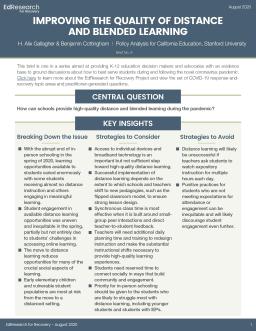Summary
This report examines California's Local Control Funding Formula (LCFF) after eight years and suggests refinements to improve equitable funding, opportunities, and outcomes. Based on interviews, research, and data analysis, the report identifies four areas for improvement: revisiting and refining the funding formula, modernizing funding for students with disabilities, equitably distributing effective teachers, and strengthening transparency, engagement, and accountability. LCFF has been viewed as an improvement over the previous system yet gaps between equity goals and local outcomes remain.
Summary
Summary
The COVID-19 pandemic has affected all students; however, its impact has been particularly devastating for students of color, students from low-income families, English learners, and other marginalized children and youth. As transmission rates decline and vaccination rates increase in California, many are eager to return to normalcy, but we must all recognize that even the prepandemic normal was not working for all students. The 2021–22 school year, therefore, constitutes a critical opportunity for schools to offer students, families, and educators a restorative restart.
Summary
Summary
California is the wealthiest state in the US, yet its school funding is insufficient to meet educational goals due to the high cost of living. A series of 12 charts provide an explanation of what is happening, with solutions outlined in the final section of an accompanying report.
Summary
California schools' funding had improved, but still fell short of what is necessary to meet the state's goals. Now, schools face three major challenges: declines in student achievement and social-emotional well-being due to COVID-19, increased costs associated with distance learning and school reconfiguration, and the need to tighten budgets. Securing necessary funding will require an enormous and sustained effort from many stakeholders to improve schools and student outcomes and strengthen the economic and social outlook for future generations.
Summary
Parental engagement is essential to improve academic outcomes for all students, particularly low-income, Black, and Latinx students. Distance learning has intensified the need for parental support, but state policies and tools for engagement are inadequate. Local Educational Agencies can remove barriers to data access and support parent engagement by following three key principles and taking related actions.
Summary
Summary
Summary
This article provides 10 recommendations based on the PACE report to help educators and district leaders provide high-quality instruction through distance and blended learning models in the 2020-21 school year. Despite the challenges of COVID-19, research can guide decisions about student learning and engagement. These recommendations can be used as a framework to prioritize quality instruction.
Summary
Summary
In the run-up to 2020 elections, where do California voters stand on key education policy issues? This report examines findings and trends from the 2020 PACE/USC Rossier poll. Key findings include rising pessimism about California education and elected officials, continued concern about gun violence in schools and college affordability, and negative opinions about higher education. However, there is substantial support for increased spending, especially on teacher salaries.
Summary
The 2018 Getting Down to Facts II research project drew attention to California’s continued need to focus on the achievement gap, strengthen the capacity of educators in support of continuous improvement, and attend to both the adequacy and stability of funding for schools. Based on the nature of the issues and the progress made in 2019, some clear next steps deserve attention as 2020 unfolds.
Summary
This report examines the early implementation of California's Statewide System of Support, which is designed to empower local educators in determining the best approaches to improvement. While COEs and district officials hold positive views of the system's emphasis on support over compliance, they have concerns about under-resourcing and the effectiveness of the Dashboard measurement tool. The report provides five recommendations to make the System of Support a more comprehensive system aligned with the Local Control Funding Formula.
Summary
Summary
Summary
Summary
Summary
Summary
Governor Newsom’s first Budget Proposal increases funding for education in California. There are areas of substantive overlap in the Budget Proposal and research findings from the Getting Down to Facts II (GDTFII) research project, released in September 2018, which built an evidence base on the current status of California education and implications for paths forward. As the Budget moves from proposal to reality, it is critical that the evidence from GDTFII continues to inform the policy process.




















